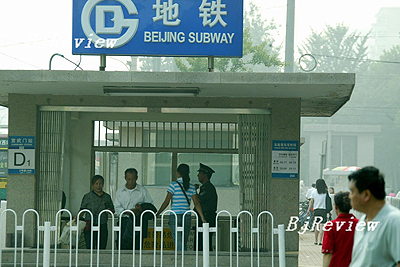
Congestion has greatly increased over time, and traffic has become congested not only during morning and evening rush hours on commutes into and then out of cities, but also during rush hours in the opposite direction as well. That is, traffic is heavy and progress is slow also going out of cities into suburbs during the morning rush hours, and back into a city during evenings. The direct cause of the growth in road congestion is the huge increase in the number of cars.
Beijing is planning to build a strong public transportation system to solve its endemic traffic problem and to cut car emission caused by the annual increased in car sales.
The city government wants to set up numerous parking lots built along the city’s metro lines and at the largest bus stations that connect Beijing’s urban areas to its outskirts. It hopes, in this way, to encourage people to park their cars and then use the public transportation system. The building of 26 mega-parking lots for car owners is currently under administrative plan. The city plans to build a more convenient transportation system to leverage the network of metro lines with bus stations.
A comprehensive public transportation network will become the capital’s key method to untie its traffic knot created by the ever larger flow of personal cars into the central area.
By 2015, the rate of public transit use is expected to reach 45 percent, 15 percent higher than present. In 2015, 19 more transportation lines, whose length will total to 561 km, will be put into operation. The new lines are going to shoulder the heavy weight of the city’s traffic pressure.
Metro Line Constructions: However, people will not need to wait till 2015 to enjoy some traffic conveniences. In September this year, Metro Line 5, regarded as the city’s main traffic artery, will be put into operation. With a length of 28 km, the subway will connect the city’s five districts -- Fengtai, Chongwen, Dongcheng, Chaoyang and Changping.
The municipal government believes the new subway can relieve the current traffic jam to some extent. Buses in Beijing receive 14 million riders a day and the new subway network is expected to be able to share the heavy burden with buses.
Metro lines are expected to receive 8 million daily riders in the year 2015 compared with present 2.2 million visits. And the construction is especially urgent before the Beijing 2008 Olympic Games.
“The constructions of Beijing’s metro lines has been speeded up in recent years,” said Liu Xiaoming, deputy director of Beijing Municipal Committee of Communications (BMCC). This year, the city has seen seven subway projects started with a length of 178 km in addition to Metro Line 5.
Metro Line 10 will be completed in 2008 and will be in service for the coming Olympic Games. The line will connect 22 stations at speeds of 80 km per hour.
Nearly 90 percent of Metro Line 4, a crucial traffic line crossing the busiest areas, including Xidan, Xizhimen and Zhongguancun, will be completed by the end of this year.
In 2008, almost 200-km metro lines will be in service. More transfer convenience will be provided to citizens when the city completes its construction of 82 interchange stations, connecting subways, bus stations and railway stations.
Traffic Jam Solution: The construction of public transportation is one solution to the city's traffic problem. Curbing the flow of personal cars into the city requires a different solution.
Despite the greater traffic congestion on roads, most men and women still choose to drive since that gives them greater flexibility about the times to travel for leisure or working.
Statistics show that Beijing’s urban area road ratio account for 17 percent of the city’s total area. The rate is lower than Tokyo, Paris and New York, whose ratios are all above 25 percent.
Cars usually crowd in the city’s central areas, like the 2nd Ring Road, the 3rd Ring Road or even the 4th Ring Road. Beijing being an ancient city with numerous architectural relics, it can hardly implement big changes to its urban areas. But there are other methods.
Parking charges have become a key way for the city to control its cars. According to the BMCC, since situations are differed from urban and suburban areas, policies to solve the traffic jam will be diversified in line with varied conditions.
The city will tighten the control to curb personal cars in its central areas but loosen its control in suburban districts. This year, the city’s parking fees in urban areas will be higher than suburban areas, charges of ground parking will be higher than underground parking, and day parking will be higher than the parking at night. And roadside parking cost will be raised from its original 2.5 yuan per half an hour.
In addition, the municipal government will raise parking fees in business centers of urban districts. The coming change in parking fees aims to encourage more people to take public transportation and cut the traffic flow of personal cars.
Vehicle population in Beijing hit 3 million in May -- a 1 million increase over three years.
(Source: People’s Daily, edited and translated by Wu Jin) | 